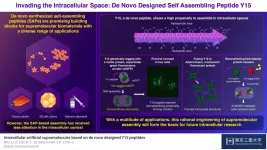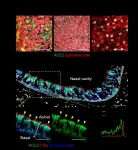Researchers identify brain circuit for spirituality
Using datasets from neurosurgical patients and those with brain lesions, investigators mapped lesion locations associated with spiritual and religious belief to a specific human brain circuit
2021-07-01
(Press-News.org) More than 80 percent of people around the world consider themselves to be religious or spiritual. But research on the neuroscience of spirituality and religiosity has been sparse. Previous studies have used functional neuroimaging, in which an individual undergoes a brain scan while performing a task to see what areas of the brain light up. But these correlative studies have given a spotty and often inconsistent picture of spirituality. A new study led by investigators at Brigham and Women's Hospital takes a new approach to mapping spirituality and religiosity and finds that spiritual acceptance can be localized to a specific brain circuit. This brain circuit is centered in the periaqueductal gray (PAG), a brainstem region that has been implicated in numerous functions, including fear conditioning, pain modulation, altruistic behaviors and unconditional love. The team's findings are published in Biological Psychiatry.
"Our results suggest that spirituality and religiosity are rooted in fundamental, neurobiological dynamics and deeply woven into our neuro-fabric," said corresponding author Michael Ferguson, PhD, a principal investigator in the Brigham's Center for Brain Circuit Therapeutics. "We were astonished to find that this brain circuit for spirituality is centered in one of the most evolutionarily preserved structures in the brain."
To conduct their study, Ferguson and colleagues used a technique called lesion network mapping that allows investigators to map complex human behaviors to specific brain circuits based on the locations of brain lesions in patients. The team leveraged a previously published dataset that included 88 neurosurgical patients who were undergoing surgery to remove a brain tumor. Lesion locations were distributed throughout the brain. Patients completed a survey that included questions about spiritual acceptance before and after surgery. The team validated their results using a second dataset made up of more than 100 patients with lesions caused by penetrating head trauma from combat during the Vietnam War. These participants also completed questionnaires that included questions about religiosity (such as, "Do you consider yourself a religious person? Yes or No?").
Of the 88 neurosurgical patients, 30 showed a decrease in self-reported spiritual belief before and after neurosurgical brain tumor resection, 29 showed an increase, and 29 showed no change. Using lesion network mapping, the team found that self-reported spirituality mapped to a specific brain circuit centered on the PAG. The circuit included positive nodes and negative nodes -- lesions that disrupted these respective nodes either decreased or increased self-reported spiritual beliefs. Results on religiosity from the second dataset aligned with these findings. In addition, in a review of the literature, the researchers found several case reports of patients who became hyper-religious after experiencing brain lesions that affected the negative nodes of the circuit.
Lesion locations associated with other neurological and psychiatric symptoms also intersected with the spirituality circuit. Specifically, lesions causing parkinsonism intersected positive areas of the circuit, as did lesions associated with decreased spirituality. Lesions causing delusions and alien limb syndrome intersected with negative regions, associated with increased spirituality and religiosity.
"It's important to note that these overlaps may be helpful for understanding shared features and associations, but these results should not be over-interpreted," said Ferguson. "For example, our results do not imply that religion is a delusion, that historical religious figures suffered from alien limb syndrome, or that Parkinson's disease arises due to a lack of religious faith. Instead, our results point to the deep roots of spiritual beliefs in a part of our brain that's been implicated in many important functions."
The authors note that the datasets they used do not provide rich information about the patient's upbringing, which can have an influence over spiritual beliefs, and that patients in both datasets were from predominantly Christian cultures. To understand the generalizability of their results, they would need to replicate their study across many backgrounds. The team is also interested in untangling religiosity and spirituality to understand brain circuits that may be driving differences. Additionally, Ferguson would like to pursue clinical and translational applications for the findings, including understanding the role that spirituality and compassion may have in clinical treatment.
"Only recently have medicine and spirituality been fractionated from one another. There seems to be this perennial union between healing and spirituality across cultures and civilizations," said Ferguson. "I'm interested in the degree to which our understanding of brain circuits could help craft scientifically grounded, clinically-translatable questions about how healing and spirituality can co-inform each other."
INFORMATION:
Funding for this work was provided by an NIH Ruth L. Kirschstein National Research Service Award (NRSA) Institutional Research Training Grant (T32MH112510), the Shields Research Grant from the Child Neurology Foundation, the Sidney R. Baer, Jr. Foundation, the Nancy Lurie Marks Foundation, the Mather's Foundation, the Kaye Family Research Endowment, and the National Institutes of Health (grants R01 MH113929, R01 MH115949, and R01 AG060987).
Paper cited: Ferguson, M et al. "neural circuit for spirituality and religiosity derived from patients with brain lesions" Biological Psychiatry DOI: 10.1016/j.biopsych.2021.06.016
ELSE PRESS RELEASES FROM THIS DATE:
2021-07-01
Over the last two decades, biomaterials research has made significant progress, transitioning from traditional biomaterials to biomaterials with controlled structure and dynamic functionality. A number of building blocks have been explored for developing biomaterials by self-assembly, but SAPs have garnered special attention due to their tunability and potential use in various applications such as tissue engineering, wound healing, and vaccinations. Despite these benefits, the SAP-based approach is less explored in the intracellular context.
Fortunately, a team of scientists from the Tokyo Institute of Technology (Tokyo Tech), led by Assistant Prof. Takayuki Miki, have reported a de novo peptide, Y15, that ...
2021-07-01
Boulder, Colo., USA: The Geological Society of America regularly publishes
articles online ahead of print. GSA Bulletin topics include
multiple articles about the dynamics of China and Tibet; the end-Permian
terrestrial extinction paradigm in South Africa; prehistoric lava flows
from the urban district of Catania (Etna volcano, Italy); the debated
origins of granite, and "a tale of two Tweefonteins." You can find these
articles at
https://bulletin.geoscienceworld.org/content/early/recent
.
Authigenic berthierine and incipient chloritization in shallowly ...
2021-07-01
Most babies born prematurely or with health problems are quickly whisked away to the Neonatal Intensive Care Unit (NICU) where they might require assisted heating devices to regulate their temperature. A University of Houston College of Nursing researcher is reporting that the traditional use of cloth blankets and towels during peripherally inserted central catheter (PICC) placement may hinder heat transfer from the assisted heating mechanisms, increasing the risk for neonatal hypothermia. In Advances in Neonatal Care, Huong (Kelle) Phan, clinical assistant professor, reports that a plastic drape lowers the incidence of hypothermia.
"The use of the plastic drape is a quality improvement to reduce the hypothermia rate in very low birth-weight ...
2021-07-01
WILMINGTON, Del. (June 29, 2021) - A new report finds that 509,025 (9.17%) public high school students in 24 states experienced homelessness in spring 2019 -- three times the number recognized by the states' education agencies. This under-recognition creates gaps in funding and services needed by this vulnerable population.
Researchers from Nemours Children's Health and the University of Pennsylvania analyzed data from the Centers for Disease Control and Prevention (CDC) for public schools across 24 states and 12 school districts. During spring 2019, more than 9% of public high school students experienced homelessness during a 30-day period in the 24 states. The rate was even higher in the 12 school ...
2021-07-01
New research published today in the journal Blood Advances finds that certain factors, such as a history of severe pain episodes and coexisting organ conditions, increase the risk of severe COVID-19 illness, including hospitalization, in individuals living with sickle cell disease (SCD). According to researchers, the study results underscore the need for COVID-19 risk reduction strategies and vaccination for this medically vulnerable population.
SCD is the most common inherited red blood cell disorder in the United States, affecting an estimated 100,000 people. According to the Centers for Disease Control and Prevention, SCD affects one out of ...
2021-07-01
Understanding how viral infection occurs can provide important clues for researchers to develop strategies to prevent viral transmission and develop effective therapeutic agents and vaccines. SARS-CoV-2, the causative agent of COVID-19, enters the host cells through interaction between the virus's spike protein and the extracellular receptor binding domain of ACE2. The viral entry into the cells is completed by various proteases, which allow the viral and cell membranes to fuse together. While it is known that the upper respiratory tract becomes compromised in the early infection, the exact types of the cells that the virus infects at the earliest stage have not yet been identified.
Led by Director ...
2021-07-01
New research from the Institute of Psychiatry, Psychology & Neuroscience (IoPPN) at King's College London, in collaboration with the University of Liverpool and the Karolinska Institute, has shown that many of the symptoms in fibromyalgia syndrome (FMS) are caused by antibodies that increase the activity of pain-sensing nerves throughout the body.
The results show that fibromyalgia is a disease of the immune system, rather than the currently held view that it originates in the brain.
The study, published today in the Journal of Clinical Investigation, demonstrates that the increased ...
2021-07-01
Extreme differences in flight altitude between day and night may have been an undetected pattern amongst migratory birds - until now. The observation was made by researchers at Lund University in Sweden in a study of great snipes, where they also measured a new altitude record for migratory birds, irrespective of the species, reaching 8 700 metres.
Great snipes are shorebirds that breed in Sweden, among other places, and spend the winter in areas near the equator in Africa. Previous studies have shown that great snipes make long marathon flights of up to 6 000 kilometres lasting 60-90 hours when they migrate between breeding sites in Sweden and wintering ...
2021-07-01
Chatbots have already become a part of our everyday lives with their quick and intuitive way to complete tasks like scheduling and finding information using natural language conversations. Researchers at Aalto University have now harnessed the power of chatbots to help designers and developers develop new apps and allow end users to find information on the apps on their devices.
The chatbot -- 'Hey GUI' (pronounced goo-ee), short for Graphical User Interface, which will be presented at ACM Designing Interactive Systems 2021 on 1 July -- can answer questions by showing images and screenshots of apps, or through simple text phrases.
"Hey GUI eliminates the need for coding skills or technical ...
2021-07-01
Hundreds of different bacterial species live in and on leaves and roots of plants. A research team led by Julia Vorholt from the Institute of Microbiology at ETH Zurich, together with colleagues in Germany, first inventoried and categorised these bacteria six years ago. Back then, they isolated 224 strains from the various bacterial groups that live on the leaves of thale cress (Arabidopsis thaliana). These can be assembled into simplified, or "synthetic" plant microbiomes. The researchers thus laid the foundations for their two new studies, which were just published in the journals Nature Plants and Nature Microbiology.
Volume control of the plant response
In the first study, the researchers investigated ...
LAST 30 PRESS RELEASES:
[Press-News.org] Researchers identify brain circuit for spirituality
Using datasets from neurosurgical patients and those with brain lesions, investigators mapped lesion locations associated with spiritual and religious belief to a specific human brain circuit




